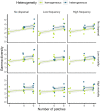Landscape configuration affects probability of apex predator presence and community structure in experimental metacommunities
- PMID: 35523981
- PMCID: PMC9120115
- DOI: 10.1007/s00442-022-05178-9
Landscape configuration affects probability of apex predator presence and community structure in experimental metacommunities
Abstract
Biodiversity is declining at an unprecedented rate, highlighting the urgent requirement for well-designed protected areas. Design tactics previously proposed to promote biodiversity include enhancing the number, connectivity, and heterogeneity of reserve patches. However, how the importance of these features changes depending on what the conservation objective is remains poorly understood. Here we use experimental landscapes containing ciliate protozoa to investigate how the number and heterogeneity in size of habitat patches, rates of dispersal between neighbouring patches, and mortality risk of dispersal across the non-habitat 'matrix' interact to affect a number of diversity measures. We show that increasing the number of patches significantly increases γ diversity and reduces the overall number of extinctions, whilst landscapes with heterogeneous patch sizes have significantly higher γ diversity than those with homogeneous patch sizes. Furthermore, the responses of predators depended on their feeding specialism, with generalist predator presence being highest in a single large patch, whilst specialist predator presence was highest in several-small patches with matrix dispersal. Our evidence emphasises the importance of considering multiple diversity measures to disentangle community responses to patch configuration.
Keywords: Dispersal; Diversity; Heterogeneity; Protected area; SLOSS.
© 2022. The Author(s).
Conflict of interest statement
The authors declare that they have no conflict of interest.
Figures





Similar articles
-
Resolving the SLOSS dilemma for biodiversity conservation: a research agenda.Biol Rev Camb Philos Soc. 2022 Feb;97(1):99-114. doi: 10.1111/brv.12792. Epub 2021 Aug 28. Biol Rev Camb Philos Soc. 2022. PMID: 34453405 Free PMC article.
-
Prey colonization in freshwater landscapes can be stimulated or inhibited by the proximity of remote predators.J Anim Ecol. 2020 Aug;89(8):1766-1774. doi: 10.1111/1365-2656.13239. Epub 2020 May 14. J Anim Ecol. 2020. PMID: 32324914
-
Maintenance of biodiversity in multitrophic metacommunities: Dispersal mode matters.J Anim Ecol. 2023 Jun;92(6):1190-1202. doi: 10.1111/1365-2656.13933. Epub 2023 May 1. J Anim Ecol. 2023. PMID: 37128152
-
Conservation value of small reserves.Conserv Biol. 2020 Feb;34(1):66-79. doi: 10.1111/cobi.13308. Epub 2019 Mar 28. Conserv Biol. 2020. PMID: 30843258 Review.
-
Host-parasitoid spatial ecology: a plea for a landscape-level synthesis.Proc Biol Sci. 2005 Nov 7;272(1578):2225-35. doi: 10.1098/rspb.2005.3286. Proc Biol Sci. 2005. PMID: 16191634 Free PMC article. Review.
Cited by
-
Corridor quality buffers extinction under extreme droughts in experimental metapopulations.Ecol Evol. 2023 Jun 1;13(6):e10166. doi: 10.1002/ece3.10166. eCollection 2023 Jun. Ecol Evol. 2023. PMID: 37274153 Free PMC article.
-
Spatiotemporal thermal variation drives diversity trends in experimental landscapes.J Anim Ecol. 2023 Feb;92(2):430-441. doi: 10.1111/1365-2656.13867. Epub 2022 Dec 15. J Anim Ecol. 2023. PMID: 36494717 Free PMC article.
References
-
- Altermatt F, Fronhofer EA, Garnier A, Giometto A, Hammes F, Klecka J, Legrand D, Mächler E, Massie TM, Pennekamp F, Plebani M, Pontarp M, Schtickzelle N, Thuillier V, Petchey OL. Big answers from small worlds: a user’s guide for protist microcosms as a model system in ecology and evolution. Methods Ecol Evol. 2015;6(2):218–231. doi: 10.1111/2041-210X.12312. - DOI
-
- Bartón K (2020) MuMIn: Multi-model inference (R. package version 1.43.17)
-
- Bartonova A, Benes J, Fric ZF, Chobot K, Konvicka M. How universal are reserve design rules? A test using butterflies and their life history traits. Ecography. 2016;39(5):456–464. doi: 10.1111/ecog.01642. - DOI
MeSH terms
Grants and funding
LinkOut - more resources
Full Text Sources
Miscellaneous

